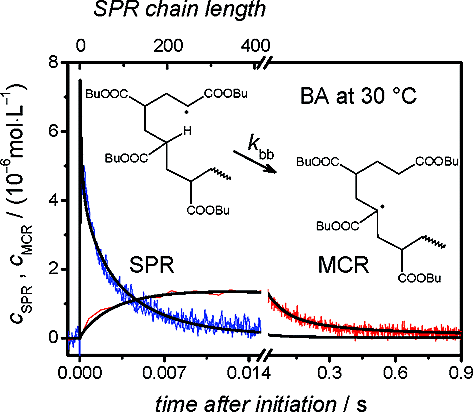
Butyl acrylate (BA) solution polymerization (1.5 M in toluene) was investigated via single-pulse pulsed laser polymerization in conjunction with electron paramagnetic resonance spectroscopy
(SP-PLP-EPR) with emphasis on the termination and transfer kinetics of the system in which two distinctly different types of radicals, secondary chain-end radicals (SPRs) and midchain radicals
(MCRs), are present. MCRs are produced by intramolecular hydrogen transfer (backbiting). They may react back to SPRs by monomer addition. The evolution of SPR and MCR concentrations after
photoinitiation with an intense laser pulse was measured via highly time-resolved EPR at temperatures between −40 and +60 °C. At very low temperatures the MCR concentration is
negligible, enabling the chain-length-dependent rate coefficient of SPR termination, ktss(i,i), to be directly determined. At higher temperatures it was
necessary to use PREDICI simulation of the radical concentration vs time traces, a process which yields the chain-length-dependent rate coefficient of SPR termination for monomeric radicals,
ktss(1,1), as well as the rate coefficients for backbiting, kbb, for monomer addition to an MCR, kpt,
and for SPR-MCR cross-termination, ktst. The composite model adequately represents ktss(i,i), with the power-law exponents
αs = 0.85 ± 0.09 and αl = 0.16 ± 0.07 for short-chain and long-chain radicals, respectively, and a crossover chain length
between short-chain and long-chain behavior at around ic = 30. The activation energy for both ktss(1,1) and
ktst(1,1) is found to be as one would expect for translational diffusion of small molecules.
